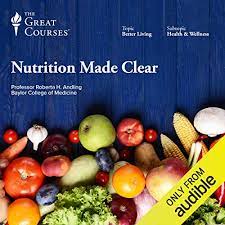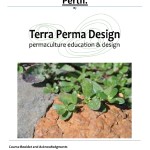
Details below and free videos for a limited time here somewhere ;o)
Table of Contents
1 Why We Eat What We Do
Studies and trends show that Americans, now more than ever, are interested in eating right. Professor Anding begins the course with a description of the current state of American nutrition, a brief introduction to the history of nutrition science, and a roadmap for the lectures ahead.
2 Sources of Nutrition Fact and Fiction
How can you make sense of the barrage of nutritional information – and misinformation – surrounding you? In this lecture, learn how to flag potential cases of health fraud and where to find credible sources of information on nutrition. Also, examine the public health policies designed to promote the well-being of Americans
3 Our Underappreciated Digestive Tract
Our remarkable digestive systems often go unappreciated – until we succumb to some sort of digestive order. Explore the basic functions of the gastrointestinal tract, common ailments that affect between 60 and 70 million Americans at one point or another, and ways to manage these ailments through dietary means.
4 It’s All about the Calories!
Over the past 50 years, the caloric intake of Americans has gradually increased. Understanding the basics of your metabolism can provide the foundation for lifelong strategies for managing weight. Here, examine the determining factors behind your daily caloric intake and learn tips on how to successfully burn calories.
5 Hydration – You Are What You Drink
Do you really need to drink eight 8-oz. glasses of water every day? Discover the science behind the water that constitutes 65% – 70% of our bodies, including a look at the symptoms and treatments of dehydration and overhydration and the effects of caffeine and alcohol on the body’s hydration levels.
6 Not All Carbohydrates Are Created Equal
Carbohydrates account for roughly 50% of the average American’s diet. In this exploration of why these biomolecules are both good and bad for us, study the functions of simple and complex carbohydrates and learn ways you can make wiser carbohydrate choices in your daily diet.
Amazon #ads

7 Facts on Fiber
Whole-grain cereals, nuts, fruits – these are just a few of the many sources of fiber that are part of a healthy diet. Here, examine the differences between insoluble and soluble fibers and the health benefits of a high-fiber diet for everything from promoting digestive health to controlling blood sugar levels.
8 Protein – An Indispensable Nutrient
Protein is, without a doubt, an indispensable nutrient. But how do proteins function? What are the appropriate protein needs for an average adult? And what can happen if you don’t get enough protein in your daily diet? Discover the answers to these and other questions in this insightful lecture.
9 Fat, Fat Everywhere!
Make sense of the scientific complexities of dietary fat in all its many forms: saturated, unsaturated, trans-fat, cholesterol, and more. Professor Anding helps you distinguish between “good” and “bad” fats and shows you how to regulate dietary fat intake.
10 Vitamins – Spotlight on C
Of all the 13 different vitamins we get through diet or supplementation, Vitamin C is one of the most popular. Investigate the history, benefits, dietary sources, and daily requirements of this water-soluble vitamin. Also, learn the truth about whether Vitamin C can protect you from the common cold.
11 Vitamins A and K – Multitaskers
Continue studying vitamins with a look at two that are fat-soluble: Vitamins A and K. For each of these multitasking vitamins, discover their purpose; where you can find them in the foods you eat; what your daily requirements should be; and what happens when you get too little – or too much – of each in your diet.
12 Vitamin E – Fallen Hero; Vitamin D – Rising Star
In this third lecture on vitamins, focus on Vitamins E and D. Contrary to popular thought, Vitamin E has proven to not be so helpful in the prevention of chronic disease. Vitamin D, on the other hand, may play a role in combating diseases such as diabetes and cancer, according to emerging science.
Amazon #ads

13 B Vitamin Basics
Vitamin B consists of not one, but of eight different substances that help enable the release of energy from the food you eat. Here, examine the most familiar B vitamins (including thiamin, niacin, and folate) and some of the myths associated with B-vitamin nutrition.
14 The Major Minerals
There are seven major minerals that are essential to your everyday life: calcium, phosphorous, potassium, sulfur, sodium, chlorine, and magnesium. This lecture serves as an illuminating primer on the need for these minerals in your diet and focuses on the two that are the most important.
15 The Highs and Lows of Sodium and Potassium
These two counterbalancing minerals play a major role in maintaining normal blood pressure. How does this happen? How many milligrams of each should you incorporate into your daily diet? And what are some successful ways to limit your amount of sodium intake? Find out in this lecture.
16 Iron, Zinc, Selenium – Balance Is Everything
Round out your study of minerals by learning about iron, zinc, and selenium. These three minerals play integral roles in the functioning of your immune system, interacting with more than 100 enzymes and reducing peroxide free radicals (compounds believed to cause aging and possibly cancer).
17 Cardiovascular Disease – What Are the Risks?
Approximately 50% of Americans will develop some form of heart disease within their lifetime, according to some medical sources. Survey the five major forms of cardiovascular disease – angina, atherosclerosis, heart attacks, strokes, and congestive heart failure – and discover the various risk factors you can and cannot control.
18 A Heart-Healthy Lifestyle
Using your newfound knowledge of heart disease, get detailed information on how to understand – and mitigate – your personal risk. Learn what cholesterol and triglyceride levels are appropriate and how to achieve a heart-healthy lifestyle by choosing fat-free or low-fat dairy products, eating fish at least twice a week, exercising at least 30 minutes a day, and more.
Amazon #ads

19 The DASH Diet – A Lifesaver
One out of every three Americans suffers from high blood pressure, which can lead to shorter life expectancies. As you learn the sources of hypertension, discover how the DASH – Dietary Approach to Stop Hypertension – diet, when combined with sodium restriction and weight management, can help control blood pressure.
20 Obesity – Public Health Enemy Number One
Why has obesity become such an epidemic, both in America and around the globe? Is it a result of genetics, environmental and social factors, or both? What is the difference between being obese and merely being overweight? Find out the answers to these and other questions in this eye-opening lecture.
21 Healthy Weight Management
What are the secrets to maintaining a healthy, optimal body weight? Learn some smart habits here, including balancing your energy sources, exercising regularly, and maintaining a positive outlook. Also, take a look at the American Dietetic Association’s 10 key recommendations for cutting calories in your daily diet.
22 Metabolic Syndrome and Type 2 Diabetes
Delve into the causes, prevention, and treatment of both metabolic syndrome (clustered risk factors that can be a precursor to Type 2 diabetes) and Type 2 diabetes itself. Then, touch on the reasons behind rising levels of this disease in American children – some as young as four years of age.
23 Dietary Approaches to Weight Management
Popular diets. Over-the-counter supplements. Gastric banding surgery. Get detailed explanations of the science behind – and flaws in – these and other popular weight-loss methods. Professor Anding then gives you alternative approaches to long-term weight management, using data from the National Weight Control Registry
24 Nutrition and Cancer Prevention
While cancer is currently the second leading cause of death in the United States, there is a wealth of dietary strategies and lifestyle modifications that can help people reduce their risk of this fearful diagnosis. Discover them here.
Amazon #ads

25 Nutrition and Digestive Health
Professor Anding guides you through the normal digestive process and points out the characteristics of common digestive disorders. Learn how wise dietary decisions, lifestyle changes, and medication can help control lactose intolerance, celiac disease, irritable bowel syndrome, and more.
26 Prebiotics and Probiotics in Your Diet
Professor Anding guides you through the normal digestive process and points out the characteristics of common digestive disorders. Learn how wise dietary decisions, lifestyle changes, and medication can help control lactose intolerance, celiac disease, irritable bowel syndrome, and more.
27 Food Safety – It’s in Your Hands
While the U.S. food supply is one of the safest in the world, recent outbreaks of salmonella and E. coli show that we should still be concerned with the contamination. Increase your awareness of food safety by exploring food contamination methods, the consequences of food-borne illnesses, and practical prevention methods.
28 Demystifying Food Labels
We’ve all read a food label. But what do you really need to know to make wise, healthy choices? This lecture reveals the best ways to read the back of a package for nutrition information and includes Professor Anding’s useful tips on how to avoid making serious mistakes when selecting food.
29 Facts on Functional Foods
Are functional foods – foods that provide additional health benefits that may reduce disease risk and promote optimal health – worth your extra money? Come to your own conclusion in this lecture, which gives you definitions and examples of functional foods, as well as information on how these foods are marketed and regulated.
30 A Look at Herbal Therapy
The last decade has seen a dramatic increase in the use of herbal medicine as a means to prevent or manage disease. This lecture explores the myths and realities behind this alternative form of medicine, with an emphasis on a few of the most popular supplements, including St. John’s wort, ginkgo biloba, and ginseng.
Amazon #ads

31 Organic or Conventional – Your Choice
An estimated 81% of shoppers buy organic food because they feel it has a higher nutritive value than conventional foods. So are there significant health benefits to eating organic foods? Here, Professor Anding defines types of organic products and details current research about their nutritional advantages.
32 Fake or Real – Sugars and Fats
Nine out of 10 Americans buy or consume products made with artificial sweeteners and fat replacers – so much that it can be difficult to determine if what we’re eating is real or fake. Examine the nutritional advantages and disadvantages of consuming products made with sucrose, fructose, Olestra, and other additives.
33 Creating Your Own Personal Nutrition Plan
Here, personalize the knowledge you’ve gained from earlier lectures by learning how to design your own basic nutrition plan. Explore the four components required to determine your nutritional needs, uncover useful tips to keep in mind as you develop your strategy, and put it all together with concrete examples.
34 Exercise and Nutrition – Partners for Life
Being healthy is not just a matter of what you eat, it’s a matter of how much daily physical activity you get. Discover the components of a practical exercise program and learn how you can implement the right amount of physical activity into your own personal lifestyle – activity that can often prevent many diseases and detrimental health conditions.

35 The Future of Nutrition – Science and Trends
Cast your gaze upon the future of nutrition science. How have scientific breakthroughs (such as the Human Genome Project) allowed for the creation of individualized health goals? Will consumers make more home-cooked meals instead of relying on convenience foods? What foods will we start eating more and less of?
36 Nutrition Facts and FAQs
Nutrition is a very broad and personal subject, and so it’s inevitable that many questions will remain. That’s why Professor Anding concludes the course with an entire lecture devoted to her own expert responses to common nutrition questions she’s been asked during her career.
Glossary
Bibliography



